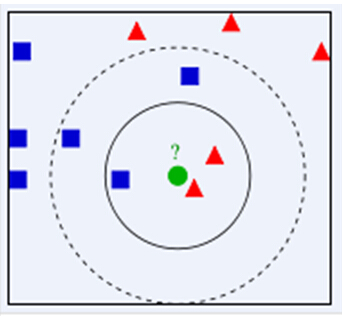機器學習實戰讀書筆記(1)--k鄰近演算法
kNN演算法
kNN演算法概述
knn工作原理:

存在一個樣本資料集合(訓練樣本集),並且每個樣本都具有標籤,輸入新的樣本後,我們將樣本的特徵與訓練樣本集中的資料特徵比較,演算法提取特徵最相似的k個樣本的標籤,採用少數服從多數的形式,認為新樣本的標籤就是最相似的k個樣本中的主要標籤.
def classify0(inX,dataSet,labels,k):
'''
inX 待分類元素,是一個list
dataset 訓練樣本集,是一個array物件
labels 訓練樣本集標籤
k kNN中的取前幾相近資料判斷
''' group,labels = createSet()
classify0([0,0.14],group,labels,3)[('B', 2), ('A', 1)]
'B'
tile(item,dim)–tile函式用於將item按照dim複製成一個更大的向量,返回一個array
operator.itemgetter(i)– 顧名思義返回的是一個方法(函式),用來獲取輸入引數的第i+1個值
以上實現了一個簡單的knn分類器,完成了knn演算法的核心部分,但並不實用.
書中通過兩個例項,提高約會網站配對和?完整的演示機器學習演算法的流程
例1 實用knn演算法改進約會網站的配對效果
準備資料 從文字解析資料
資料是1000行約會網站的男性資訊,包括
- 每年獲得的飛行常客里程數
- 玩視訊遊戲所耗的時間百分比
- 每週消費的冰淇淋公升數
首先對資料進行處理和初步的觀察
def file2matrix(filename):
fr = open(filename)
arrayOLines = fr.readlines()
numberOfLines = len(arrayOLines)
returnMat = zeros((numberOfLines,3))
classLableVector = []
index = 0
for line in arrayOLines:
line = line.strip()
listFromLine = line.split('\t')
returnMat[index,:] = listFromLine[0:3]
classLableVector.append(int(listFromLine[-1]))
index += 1
return returnMat,classLableVector
datingDataMat, datingLabels = file2matrix('/home/caid/mycode/MachineLearningInAction/MLIA_self/ch_02/datingTestSet2.txt')
fig = plt.figure()
ax = fig.add_subplot(111)
ax.scatter(datingDataMat[:,1],datingDataMat[:,2],15.0*array(datingLabels),15.0*array(datingLabels))<matplotlib.collections.PathCollection at 0x7f4001515898>
準備資料:歸一化資料
為了避免特徵之間,差值大的特徵對結果影響大,差值小的資料對結果影響小,需要對資料進行歸一化.歸一化的幾種方式,和標準化的區別.
歸一化的原理:
在下面這個自動歸一化的函式中,多次使用tile將一個一維的陣列複製成dataset的大小,利用Numpy中運算子是對元素操作的特點,兩步計算得到歸一化的資料集.
def autoNorm(DataSet):
Maxval = DataSet.max(0)
Minval = DataSet.min(0)
ranges = Maxval - Minval
NormDataSet = zeros(shape(DataSet))
m = DataSet.shape[0]
NormDataSet = DataSet - tile(Minval,(m,1))
NormDataSet = NormDataSet/tile(ranges,(m,1))
return NormDataSet,ranges,MinvalnormMat,ranges,minVals = autoNorm(datingDataMat)
normMat
ranges
minValsarray([[ 0.44832535, 0.39805139, 0.56233353],
[ 0.15873259, 0.34195467, 0.98724416],
[ 0.28542943, 0.06892523, 0.47449629],
...,
[ 0.29115949, 0.50910294, 0.51079493],
[ 0.52711097, 0.43665451, 0.4290048 ],
[ 0.47940793, 0.3768091 , 0.78571804]])
array([ 9.12730000e+04, 2.09193490e+01, 1.69436100e+00])
array([ 0. , 0. , 0.001156])
def datingClassTest():
hoRatio = 0.10
datingDataMat,datingLabels = \
file2matrix('/home/caid/mycode/MachineLearningInAction/MLIA_self/ch_02/datingTestSet2.txt')
m = datingDataMat.shape[0]
numTestVecs = int(m*hoRatio)
NormDataMat,ranges,minvals = autoNorm(datingDataMat)
errorCount = 0.0
for i in range(numTestVecs):
label = classify0(NormDataMat[i,:],\
NormDataMat[numTestVecs:m,:],datingLabels[numTestVecs:m],3)
# print("hte classifier came back with: %d, the real answer is %d" %(label,datingLabels[i]))
if label != datingLabels[i]:errorCount += 1.0
print("the total error rate is %.3f%%" %(errorCount/float(numTestVecs)*100.0))
datingClassTest()the total error rate is 5.000%
通過測試演算法,可以看出這個分類器的結果的錯誤率在5%左右.為了使用演算法,需要提供一個介面
使用演算法:構建可用的系統
def classifyPerson():
resultList = ['not at all','in small doses','in large doses']
percentTats = float(input("percentage of time spent playing video game?"))
ffMiles = float(input("ffmiles:"))
iceCream = float(input("iceCream:"))
datingDataMat,datingLabels = file2matrix('/home/caid/mycode/MachineLearningInAction/MLIA_self/ch_02/datingTestSet2.txt')
normMat,ranges,minVals = autoNorm(datingDataMat)
inArr = array([ffMiles,percentTats,iceCream])
label = classify0((inArr-minVals)/ranges,datingDataMat,datingLabels,3)
print("you will probably like this person:",\
resultList[label-1])classifyPerson()percentage of time spent playing video game?10
ffmiles:10000
iceCream:0.5
you will probably like this person: in small doses
上例介紹瞭如何在資料中使用kNN分類器,下面這個例子將介紹如何在二進位制資料中利用kNN
例2 手寫識別系統
def img2vector(filename):
returnVector = zeros((1,1024))
fr = open(filename)
for i in range(32):
lineStr = fr.readline()
for j in range(32):
returnVector[0,32*i+j] = int(lineStr[j])
return returnVector這是一個將測試資料轉換為資料集的一部分的函式,將一個32*32的方陣轉化為一個1*1024的行向量
接下來測試一下這個函式
testVector = img2vector('MLIA_self/ch_02/testDigits/0_13.txt')
testVector[0:32]array([[ 0., 0., 0., ..., 0., 0., 0.]])
from os import listdir
def handWritingClassTest():
hwLabels = []
trainingFileList = listdir('MLIA_self/ch_02/trainingDigits')
m = len(trainingFileList)
trainingMat = zeros((m,1024))
for i in range(m):
filenameStr = trainingFileList[i]
fileStr = filenameStr.split('.')[0]
classLabel = int(fileStr.split('_')[0])
hwLabels.append(classLabel)
trainingMat[i,:] = img2vector('MLIA_self/ch_02/trainingDigits/%s' %filenameStr)
testFileList = listdir('MLIA_self/ch_02/testDigits')
n = len(testFileList)
errorcount = 0.0
for i in range(n):
filenameStr = testFileList[i]
fileStr = filenameStr.split('.')[0]
classLabel = int(fileStr.split('_')[0])
#hwLabels.append(classLabel)
testImg = img2vector('MLIA_self/ch_02/trainingDigits/%s' %filenameStr)
classifyResult = classify0(testImg,trainingMat,hwLabels,3)
# 第一次做計算還是沒有想清楚k是什麼,是最鄰近範圍,而不是測試集大小,也不是分成幾類
if classifyResult != classLabel:
errorcount += 1.0
print("the number of error is : %f" % errorcount)
print("the error rate is : %f " %(errorcount/float(n)))
handWritingClassTest()the number of error is : 11.000000
the error rate is : 0.011628
之所以kNN演算法能夠用在手寫數字識別上,並且能夠得到較好的結果,我認為從影象的角度看,同一個數字在影象中存在畫素的位置是相近的,如果兩個手寫數字的影象,有畫素的位置重合最多(即計算出來的距離最小)那麼它們就應該是同一個數字,對字母的識別相類似,另一方面,訓練集的數量足夠多,也是能夠達到較好效果的關鍵.
kNN演算法總結
kNN是分類資料最有效最簡單的演算法之一,但是使用演算法時,knn需要儲存全部資料集,並且對資料集中的每個資料計算距離,實際上需要大量的空間和時間開銷,另一個缺陷是無法給出任何資料的基礎結構資訊(什麼是基礎結構資訊?)因此,也無法知曉平均例項樣本和典型例項樣本具有什麼特徵.

